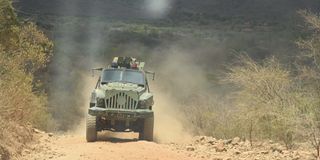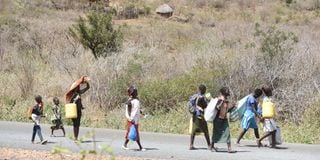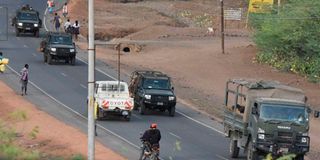What it will take to silence guns in Kerio Valley

An armored personnel carrier patrols Marigat-Mochongoi road in Baringo County on February 16, 2023. More Kenya Defense Forces troops have been spotted arriving in Baringo as operation to flush out bandits kicks off in the Rift Valley region.
In November 2012, some 42 officers were ambushed at the Suguta Valley in Turkana and killed. It was one of the deadliest attacks on the police within the northern Kenya cattle complex. While the army was sent to “finish banditry” in the region once and for all, it appears that cattle rustling continues to thrive in the entire northern belt of Kenya – a region awash with small arms.
This week, a former Rift Valley regional commander, George Natembeya, alluded that political leaders of the regions prone to “banditry” are not innocent bystanders in the organised violence. He told President William Ruto that this is complex territory – and that previous efforts to restore order were sabotaged.

Women and children were spotted in Sinoni area in Mochongoi, Baringo County on February 16, 2023. They were returning to their homes in Seretion village from Romulel village, 10 kilometres away, where they normally spend their night out of fear of being attacked by armed bandits armed at night.
Over the last week, armed clashes between South Sudan’s Toposa and Kenya’s Turkana took place in the Ilemi triangle over pastures. The clashes were also about the national border – left to the armed Turkana to secure from the Kenyan side.
As the military and police move into the cattle complex to disarm all the militarised communities, the complexity of the exercise will emerge. If the Turkana, for instance, are disarmed, they will be overrun and impoverished by the Toposa – unless the military stays in the north to protect the community. But, on the other hand, if the Pokot are disarmed, and the Turkana are not – they will be impoverished within months by commercial rustlers.
The violence witnessed in the north is today no longer a show of cultural might. Instead, researchers have over the years said that what is commonly christened “banditry” are forms of ethnic cleansing, cultural cattle rustling, territorial mapping, criminal enterprise, political gerrymandering and struggles over diminishing resources.
President Ruto’s regime finds itself confronting an ancient gun culture in the north – and has to engage communities that have become the most militarised in East Africa. It is not the first time that such an exercise is taking place.
In the mid-1970s, the Jomo Kenyatta government decided to train some 250 police officers from the General Service Unit (GSU) for a new Anti-Stock Theft Unit. It was hoped that this unit, which is still in existence, would end the cattle rustling menace by carrying out preventive work and anti-stock theft operations and investigations. But the unit was rubbished in the 1980s after then Attorney-General Charles Njonjo, claimed that it was formed for an ulterior plan to manage the Kenyatta succession by staging a coup.

A Kenya Defence Forces vehicle at Marigat in Baringo County on February 17, 2023.
The group was to succeed the Kenya Police Stock Theft Unit, which had been formed in 1965 to deal with inter-tribal cattle theft in which the best thief was celebrated as a hero. While the second was personal and commercial gain and involved a few heads of cattle, this has now become a livestock business and feeds part of the Kenya meat market.
Sending of the military to fight the rustlers is not a first, either. In April 1969, the entire 7th Battalion of the Kenya Army, backed by the Air Force and police, was sent for a mission across northern Kenya in which 10,000 stolen cattle were recovered during the first week of an operation overseen by Minister for Defence Njoroge Mungai, Army Commander Joseph Ndolo, and Police Commissioner Bernard Hinga.
Initially, more tribes were involved in cattle rustling; for instance, there used to be a volatile zone between the Kuria and the Kipsigis that was eliminated after the armed Kuria surrendered their guns.
On Tuesday last week, the government declared a 30-day dusk-to-dawn curfew in six banditry-prone counties – West Pokot, Elgeyo Marakwet, Laikipia, Baringo, Samburu and Turkana. The curfew will pave the way for disarmament following the emboldened banditry attack on a police convoy in which at least three GSU officers were killed and two vehicles burnt. It was estimated that the attack on the police was carried out by more than 300 bandits, raising the possibility of the presence of an organised militia group operating in the region.
While ordering the military to step in, President Ruto appeared to appreciate the fact that the regular police and the GSU could not deal with the fluid rustlers, who retreat into the harsh terrain when pursued and hide their guns in caves, which the police have previously tried to penetrate in vain, regarding them as death traps.
In 1997, the President then, Daniel arap Moi, set up a GSU camp at Tot in Elgeyo Marakwet, hoping to end the menace and perhaps, keep the combatants at bay. But the GSU and the police were accused of colluding with the rustlers and selling bullets to them.
Initially, especially in the 1970s, it was thought that these were mainly cultural raids, and by then, the Turkana had the upper hand since they had had guns for decades. It was also argued that pastoralism was going through various shifts, and there were demands for a sedentary lifestyle. Furthermore, the previous traditional governance structures were eroded with the entry of politicians, and new centres of power had emerged. Ultimately, cattle rustling has become a political weapon, which explains the silence exhibited by leaders from the affected regions.
The proliferation of AK47s in the region has meant that President Ruto will have to face a well-armed and terrain-hardened group – some of whom are driven to war as a sign of prestige.
For many years, the Pokot were not armed with guns and were considered a docile community, relying on bows and arrows for protection. The arming of the Pokot – especially after they emptied Idi Amin’s barracks near the Kenyan border in 1979 – and parts of Marakwet means that only communal-led disarmament would eradicate the problem. But this is also complicated by the rustling between the Kenyan border and Sudan as the ongoing tussle between Toposa and Turkana, who have had guns for nearly 100 years now.

Kenya Defence Forces soldiers in a convoy at Marigat in Baringo County on Friday. A security operation involving the soldiers and police officers to flush out bandits has started in the volatile Kerio Valley region.
The Turkana had initially been armed with Austrian Steyr rifles, which they had smuggled from Ethiopia and battered for camels for years. The rifles had been introduced in the region by Italian troops in 1930s during the occupation of Ethiopia by Benito Mussolini of the National Fascist Party.
As South Sudan became a theatre of war, more guns were poured into the region, and the communities around the border acquired the weapons as the new symbol of power and pride. In 1974, the Kenyan Parliament was told that the Turkana Ngoroko – armed marauding livestock rustlers – were buying weapons from Sudan and Ethiopia. “The Turkana members of Parliament should tell their people not to buy arms and they should give us a chance to disarm them. They should tell their people not to attack other people,” said a statement from the Office of the President.
But that did not happen. Today, young boys walk around grazing cattle with AK47s and many of the “bandits” that the government will have to confront grew up owning guns. Families actually purchase guns to protect their livestock.
As the motive for cattle rustling changed from stealing to fulfill cultural expectations into a highly complex, commercial, and criminal enterprise – so did the nature of weapons used. Today, cattle rustling has become an organised commercial enterprise along the boundaries of pastoral communities to the extent that stolen cattle are never recovered – and no rustlers are taken to court.
The easy availability of guns and a ready a cattle market have made cattle raids lethal. In 2010, the Kenya Human Rights Commission concluded that beneficiaries of cattle rustling were politicians and business people who find financial benefit and political mileage in creating conflict by instigating communities to engage in cattle raiding.
Police working in the region have been accused of collaborating with cattle rustling syndicates – a network of rustlers, business people and transporters – by giving them protection to avoid arrest on the way to the market. Also in the syndicate are local administrators who issue the livestock movement permits, the most crucial document needed to ferry and transport livestock.

Some of the women and children who now spend their nights in villages that are up to 10 kilometres away from their homes, for fear of being attacked by bandits. They play hide and seek with bandits who enjoy a panoramic view of the plains from their hideouts in the nearby Korkoron hills.
Unlike when the military engaged the Sabaot Land Defence Forces by bombing them out of Mt Elgon caves, the current exercise is complicated since neither of the tribes has any known formations. More so, it is a both a war against a syndicate and a confrontation with militarised communities.
Some pundits say that as long the market for stolen animals remains unregulated, the police and the military deployed will have little chance of success. The same strategy being deployed today was tried by Dr Njoroge Mungai in 1960s and every Minister for Interior since. Will Prof Kithure Kindiki pull the miracle card?
[email protected]; @johnkamau1





